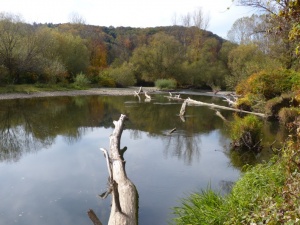Adjust land use to develop riparian vegetation
Contents
- 1 General description
- 2 Applicability
- 3 Expected effect of measure on (including literature citations):
- 4 Temporal and spatial response
- 5 Pressures that can be addressed by this measure
- 6 Cost-efficiency
- 7 Case studies where this measure has been applied
- 8 Useful references
- 9 Other relevant information
General description
Intensive anthropogenic use and alteration of riverine landscapes have led to severe degradation of river-floodplain systems, especially in highly industrialized countries. River bed erosion and loss of riparian habitat and species are among the most prominent consequences of these engineering works (Rohde et al. 2005).
The extensification of the land use at the adjacent areas of the river will lead to wider space for the development of riparian vegetation. The ability of restoration measures to host typical riparian species and to increase local plant diversity depends on the distance to near-natural stretches as the presence of a viable seed bank is an important prerequisite for the rehabilitation of natural vegetation. Passive restoration of riparian areas may be effective if invasive species do not compete with native vegetation (Roni et al. 2005).
Flood risk can be reduced through reduced runoff and increased soil water storage. Higher vegetation coverage and reduced surface flow often result in greater filtration of pollutants. Well managed meadows and pastures nearby the riparian buffers contribute to this effect by additionally reducing runoff, slowing surface flow and increasing infiltration (Kedziora et al. 2011). This would need to be coordinated at catchment scale.
Applicability
Species dispersal and establishment might be hampered by decisions taken outside the scope of the restoration project due to catchment influences (Rohde et al. 2005). It is important to ensure a coordinated riparian management effort along a catchment to achieve improvements in many chemical and ecological parameters of streams.
Expected effect of measure on (including literature citations):
| Category | Description | Source (citation) |
| HYMO | ||
| Vegetation | Riparian habitat improvement | Gundersen et al. 2010 |
| Physico-chemical parameters | Reduced nutrient loads, improved water quality | Gundersen et al. 2010; Parkyn et al. 2003 |
| Macroinvertebrats | ||
| Fish |
Temporal and spatial response
No available.
Pressures that can be addressed by this measure
Cost-efficiency
Not available.
Case studies where this measure has been applied
- Gameren
- Regge Velderberg
- Millingerwaard - Floodplain rehabilitation
- Biodiversity conservation and recovery in the river basin of Asón
- Rijkelse Bemden - River bed widening
- Thur
- Aragon. Restauration of riparian zone. Stage I and II
- Uilenkamp - Meander reconnection
- Narew river restoration project
- Aragon. Creation and restoration of a riparian zone
- Ems floodplain (LIFE project)
- Vallacuera ravine. Removal of a dyke.
- Drava - Kleblach
- Enns - Aich
- Buiten Ooij - Sluice operation
- Oberwerries - Optimisation of the pSCI “Lippe floodplain between Hamm and Hangfort” (LIFE05/NAT/D/000057)
- Soest - Optimisation of the pSCI “Lippe floodplain between Hamm and Hangfort” (LIFE05/NAT/D/000057)
- Conservation of Atlantic Salmon in Scotland (LIFE 04/NAT/GB/000250)
- IJssel
- Scheldt - Vallei Grote Nete
- Rhine - Meinerswijk
- Hampshire Avon - Hale
- Hampshire Avon - Seven Hatches
- Rhine - Emmericher Ward (LIFE10 NAT/DE/000010)
- Lower Traun
- Lippeaue Klostermersch
- Ruhr Binnerfeld
Useful references
- Gundersen, P., A. Laure´n, L. Fine´r, E. Ring, H. Koivusalo, M. Sætersdal, J.-O. Weslien, B. D. Sigurdsson, L. Ho¨gbom, J. Laine, and K. Hansen (2010). Environmental Services Provided from Riparian Forests in the Nordic Countries. AMBIO, 39, 555–566.
- Kedziora, A., Zerihun Negussie Y, Tenaw Asres M, and Zalewski M (2011). Shaping of an agricultural landscape to increase water and nutrient retention. Ecohydrology & Hydrobiology, 11(3-4), 205-222.
- Parkyn, S. M., R. J. Davies-Colley, N. J. Halliday, K. J. Costley, and G. F. Croker (2003). Planted riparian buffer zones in New Zealand: do they live up to expectations? Restoration Ecology, 11, 436–447.
- Rohde, S., M. Schutz, F. Kienast, and P. Englmaier (2005). River widening: an approach to restoring riparian habitats and plant species. River Research and Applications, 21, 1075–1094.
- Roni, P., K. Hanson, T. Beechie, G. Pess, M. Pollock, and D. M. Bartley (2005). Habitat rehabilitation for inland fisheries. Global review of effectiveness and guidance for rehabilitation of freshwater ecosystems. FAO Fisheries Technical Paper, 484.
